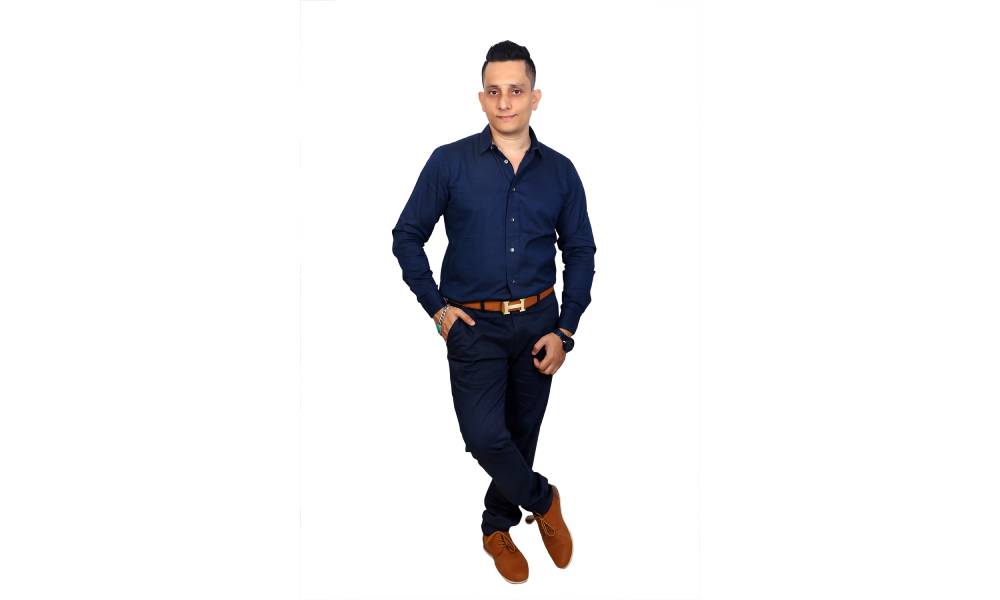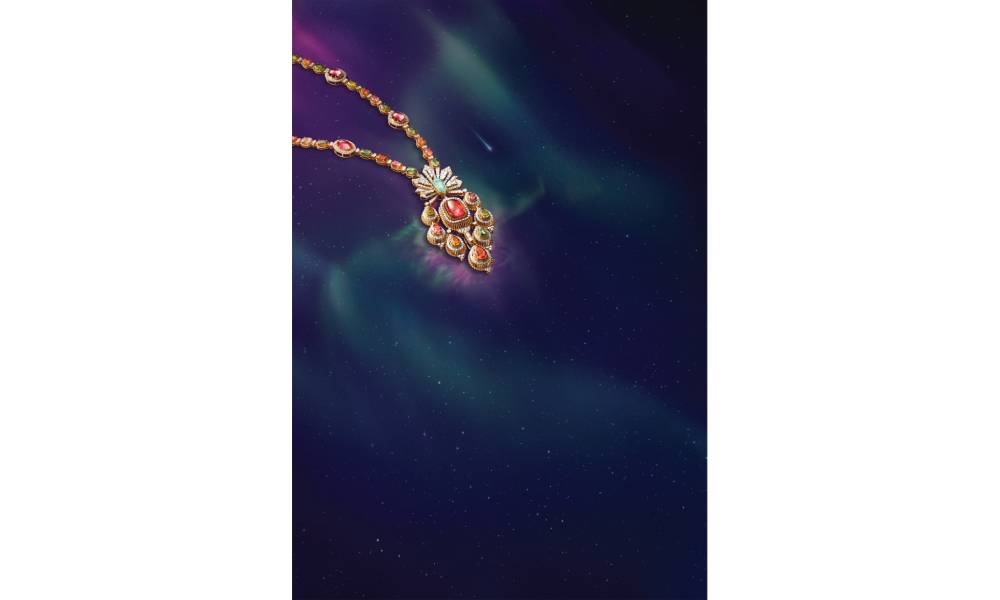Aneesh H Kumarr, Head – New Product Development (Design), Indriya – Aditya Birla Jewellery, shares his perspective in an exclusive interview with Solitaire International. While AI is undoubtedly reshaping the future of jewellery and enabling personalisation at scale, he firmly believes the artisan remains irreplaceable. He also highlights the significance of IIJS Premiere and looks forward to seeing how the industry responds with ingenuity and finesse—especially in lightweight gold jewellery. He says, “Our sourcing focus is on smart engineering and design innovation — think lightweight yet voluminous pieces crafted through hollow construction, 3D casting, and modular elements. Our sweet spot lies in festive designs priced between ₹40,000 and ₹1.2 lakhs. We’re also on the lookout for fusion pieces like polki-diamond hybrids, detachable necklaces, and regional crafts and artisanal gemstones that bring an unexpected touch of magic.”

Can you briefly share your journey into the world of jewellery design and what led you to Indriya?
Jewellery has always been more than adornment to me—it’s an emotional language, intertwining identity, culture, heritage, memory, and tradition.
Creativity runs deep in my lineage. My grandfather was a painter and theatre artist, who hand-crafted theatre backdrops in our hometown. I vividly remember sitting beside him as a child, sketching deities from calendar posters—an early connection to visual storytelling that sparked my artistic curiosity.
With the encouragement of my family, I pursued formal training in Fine Arts and later specialised in Jewellery Design & Manufacturing Techniques at JDTI, Noida. It was there that my artistic instincts found their ideal canvas, where tradition, craftsmanship, and innovation intersected beautifully.
In the mid-stage of my career, I joined the TATA Group and spent over a decade at Titan, contributing to iconic brands such as Tanishq, Mia, and Zoya. During this time, I advanced to lead the New Product Introduction function, spearheading the design and development of collections that blended cultural depth with commercial success.
The past 19 years have been deeply enriching, spanning thousands of prototypes, fieldwork across India, and collaborations with both heritage artisans and global experts. I led product design and development teams through deep R&D, innovation, and storytelling.
My move to Indriya was more than a career transition—it was a calling. When the Aditya Birla Group approached me, the jewellery business was still in its incubation phase. The brand name hadn’t even been finalised. What inspired me was the rare opportunity to build something from the ground up—a brand with national ambition and a regional soul.
I was empowered with a clean slate: to build the team, define the processes, and shape the creative vision backed by the immense trust of our Business Director. Today, as one of Indriya’s founding members, I look back with pride and forward with purpose. This is not just a role—it’s a legacy in the making.
What drives your creative process when developing a new collection?
It begins with deep listening to culture, to consumers, and to craftsmanship.
Research is the key to our process. We immerse ourselves in diverse cultural contexts, be it temple architecture, folk traditions, regional bazaars, fashion weeks, or international design expos. Inspiration can come from a forgotten folktale, a ceiling carving in a village temple, or a fleeting moment on a runway.
But design isn’t solitary, it’s collaborative. From there, it becomes an intensive co-creation journey. My team and I work closely with vendor partners, karigars, CAD artists, and design collaborators. I believe the most compelling collections don’t emerge from individual brilliance alone, but from collective synergy.
At its core, what drives me is the idea of resonance. A successful collection doesn’t just launch, it connects. It should evoke a feeling, tell a story, and mirror the aspirations of the wearer.

As someone with multiple patents, which innovation are you personally most proud of?
Among the innovations we’ve created, one stands out for its simplicity and impact: a patented, design-agnostic, lightweight mechanism that ensures a necklace stays perfectly aligned maintaining its sparkle and poise. It’s subtle, invisible to the eye, yet dramatically enhances the user experience. That, to me, is meaningful innovation where design, function, and empathy converge.
Beyond patents, we continue to explore new ideas, and one initiative I deeply value is our modular bridal jewellery concept. We noticed that brides often invest in ornate pieces that are worn once and then locked away. In response, we developed transformable jewellery that transitions seamlessly from the wedding to the reception and even festive occasions.
This isn’t just about versatility, it’s about sustainability, emotional longevity, and ergonomic design.
For me, innovation isn’t about reinvention for novelty’s sake, it’s about solving real problems with elegance.
How do you merge traditional Indian artistry with contemporary global trends in your designs?
My design philosophy is deeply rooted in India’s rich cultural heritage, yet it resonates with global sensibilities.
At Indriya, we honour the artistry of skilled craftsmen by blending age-old traditions with emerging trends to meet the aspirations of modern consumers. We actively champion regional craftsmanship to set our collections apart in a competitive industry.
Tradition and modernity are not opposites, they are collaborators. Our aim is to create jewellery that pays tribute to the past, reflects the present, and anticipates the future.
Through our Kaarigari Stories film series, we celebrate the brilliance of Indian artisans while highlighting how their craft is evolving through contemporary narratives. For us, tradition and innovation are not in conflict, they are co-authors of what’s to come.
What role does sustainability or material innovation play in your product development process?
Sustainability is no longer a choice, it’s a responsibility.
At Indriya, we are committed to responsible sourcing, partnering with vendors who provide traceable, ethically sourced gold and conflict-free diamonds. We are also exploring capsule collections in recycled gold, as well as eco-friendly enamels and alternatives to traditional gemstones.
Our design philosophy aligns with mindful luxury, creating versatile, modular pieces that reduce wardrobe redundancies and encourage reuse across occasions. We’ve also integrated digital prototyping in our R&D processes, significantly minimising material waste in early stages.
Moreover, we promote additive manufacturing techniques, which drastically reduce gold wastage compared to traditional subtractive processes.
Sustainability, for us, extends beyond materials, it’s embedded in our design thinking, production choices, and long-term brand vision.
How do you strike a balance between design vision and commercial viability?
That, to me, is the essence of successful product development.
Design without market relevance becomes art; commerce without creativity becomes transactional. The sweet spot lies in marrying aspiration with analytics.
We begin every collection with uninhibited ideation, no filters. Then, through a data-informed lens, we evaluate design directions using price point analysis, sell-through history, regional preferences, and competitive benchmarks.
We ask tough questions: Does this piece offer value at its price point? Does it reflect regional aesthetics? Is it ergonomically sound?
I often tell my team, dream fearlessly, but anchor your execution in empathy and insight. When a product delights the eye, sits comfortably on the body, and moves off the shelf, you’ve found that elusive sweet spot.
What are you most looking forward to at IIJS Premiere this year—in terms of trends, collaborations, or inspiration?
IIJS Premiere is where India’s jewellery ecosystem renews itself.
This year, I’m excited about the energy young artisans and second-gen entrepreneurs are bringing, especially in categories like lightweight bridal, occasion wear, and convertible jewellery. There’s a growing demand for versatility, value, and emotional resonance.
I’m also keen to explore the convergence of jewellery with technology—Augmented Reality, textile craft, digital twins, and even AI-influenced aesthetics. The blurring of these boundaries is where the next big ideas will emerge.
With gold prices at historic highs, lightweight engineering and material efficiency are no longer optional—they’re strategic necessities. I’m keen to see how the industry responds with ingenuity and finesse.
For me, IIJS isn’t just about what’s on display, it’s about the future being imagined in real time.
Tell us more about tech disruption and how it will impact the jewellery industry.
We’re at the cusp of a technological renaissance in the Indian jewellery industry.
From AI-driven product planning to virtual try-ons using augmented reality, technology is transforming how consumers discover, experience, and personalise jewellery. At Indriya, we recently launched an AI-powered bridal campaign where customers could virtually star in our brand film, originally featuring Aditi Rao Hydari. It wasn’t just marketing; it was emotional engagement at scale.
Blockchain is another game-changer. Platforms like Tracr are enabling end-to-end diamond traceability, building trust and transparency for today’s conscious consumer.
AI-powered customisation is also unlocking hyper-personalisation at scale.
But here’s what I truly believe: technology will never replace the artisan; it will empower them. By enhancing precision, storytelling, and scalability, it amplifies the human touch.
The future of jewellery will belong to those who can harmonise code with craft, where algorithms and artistry co-create the extraordinary.
Box
Trend directions by Aneesh Kumarr
In gold, there’s a beautiful blend of heritage and modernity taking shape. Bridal jewellery continues to honour regional traditions — from Lakshmi, peacock and mango malas in the South to kundan polki florals in the North. But now, these classics are being reimagined with lighter, modular constructions making them more versatile for today’s bride.
In daily wear, the mood is soft yet expressive. With nature-inspired motifs, celestial symbols, spiritual engravings and stackable forms across regions, we are seeing enamel accents, matte textures, and multifunctional silhouettes, especially among the younger consumers. There is a subtle shift towards meaningful pieces rooted in regional craftsmanship like nakshi, meenakari and geometric filigree.
In diamonds, there is a definite move towards personalisation and modularity, especially in bridal and high-end collections where convertible sets, layering, and non-traditional shapes are trending. Baguettes, pears, marquise and illusion-setting are being paired with natural gemstones like emeralds, rubies, and sapphires.
For bold contrast in daily wear, we are embracing micro setting, high polish finishes for clean and modern silhouettes.

